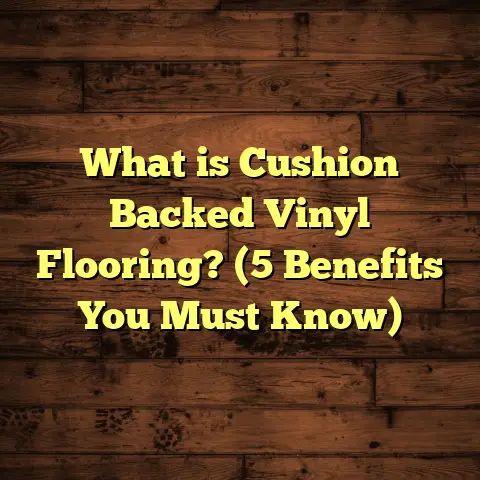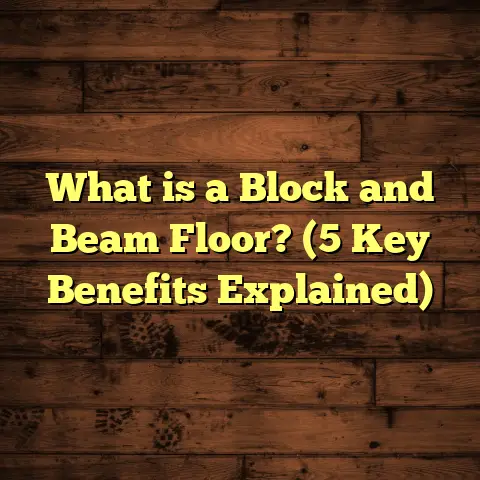What is Feather Floating a Floor? (5 Key Benefits Revealed!)
When I was choosing flooring for my home, my pets were a big part of the decision. Having a dog that loves to run around and a cat that enjoys scratching, I had to find something durable, easy to clean, and comfortable for them. That’s when I stumbled upon a method called feather floating a floor. It sounded unusual at first, but I soon realized it could be a fantastic solution for pet owners like me.
What is Feather Floating a Floor?
So, what exactly is feather floating a floor? Simply put, feather floating is a flooring installation technique where the floorboards or tiles are laid over an underlayment or subfloor without being nailed or glued down. The term “feather” refers to the light, almost weightless feel of the flooring once installed — it “floats” above the base layer. This method allows the floor to expand and contract naturally with changes in temperature and humidity without cracking or buckling.
Unlike traditional flooring methods that fix the floor permanently, feather floating creates a flexible surface. Usually, the layers are locked together with tongue-and-groove joints or click-lock systems. The entire floor “floats” over a cushioning layer made from foam, cork, or rubber, providing soundproofing and extra comfort underfoot.
My first experience with this technique came when I installed laminate flooring in my living room. I wanted something that would hold up to my dog’s claws without damaging the floor or needing constant repairs. Feather floating was perfect because it gave me an easy-to-install, durable floor that’s still soft enough for my pets to enjoy.
Why Feather Floating Feels Right for Pet Owners
Have you ever noticed how your pets react to different floor surfaces? Hard tiles can be slippery and cold, while certain hardwoods might get scratched easily. Floating floors tend to have a bit of “give,” making them softer for paws and joints. Plus, since they’re not glued down, if anything goes wrong with one section, repairs are straightforward.
5 Key Benefits of Feather Floating Floors
Let me share the main reasons why I recommend feather floating floors — especially if you have pets or want a hassle-free flooring option.
1. Durability and Resistance to Wear
One of my biggest worries was how quickly my floors would wear out with a busy dog running around. Feather floating floors often use laminate or engineered wood, materials designed to resist scratches, dents, and stains better than traditional hardwood.
According to a study by the National Wood Flooring Association (NWFA), laminate floors installed with floating methods can withstand up to 30% more surface wear compared to nailed hardwood floors. This means fewer scratches from claws and less fading from sunlight—something I’ve noticed firsthand after two years of heavy use.
Also, because the floor isn’t attached rigidly to the subfloor, it can handle slight movements without cracking or splitting. This flexibility is a lifesaver in homes with pets who love jumping or sliding across rooms.
I remember when my Labrador Retriever first got her claws trimmed but was still adjusting to walking on smooth surfaces. The floating laminate floor gave just enough grip so she wasn’t slipping all over the place like she did on my old polished hardwood. It felt like the floor had some give but was still firm enough to support her weight comfortably.
Laminate flooring is often coated with a wear layer that protects against stains and UV damage. This means it holds up well even in sunny rooms where sunlight could otherwise bleach traditional hardwood floors over time.
The Science Behind Durability
Laminate floors have multiple layers: a melamine resin wear layer on top, followed by a photographic applique layer (which gives texture and design), core layers usually made from high-density fiberboard (HDF), and a backing layer for moisture resistance.
This structure offers a hardness rating between 6-8 on the Janka hardness scale (a standard test measuring hardness of wood materials), making them highly resistant to dents and scratches from pet nails.
In contrast, traditional hardwood floors can range from 3-7 on the Janka scale depending on species but are more vulnerable because they are nailed down and can crack if stressed.
2. Easy Installation Saves Time and Money
What really surprised me was how feather floating floors cut down on installation time. Traditional hardwood needs nails or glue and can take several days to install properly. Floating floors snap together quickly, often ready to walk on within hours.
In fact, according to data from FloorTally, using floating floor installations can reduce labor costs by up to 40%. For DIY enthusiasts like me, it’s a huge bonus — less hassle, less mess, and no need for specialized tools.
If you’ve ever tried installing flooring yourself, you know how intimidating it can be. Floating floors come with clear instructions and often don’t require nails or glue, so you can pop pieces together like puzzle parts.
When I first installed my laminate floating floor, I didn’t expect it to be so straightforward. The planks clicked into place with minimal effort. I just needed an underlayment roll beneath for cushioning and moisture barrier purposes. The entire living room was done in less than two days without professional help.
Step-by-Step Installation Process
- Preparation: Remove old flooring or carpet, clean subfloor thoroughly.
- Underlayment: Roll out foam or cork underlayment for cushioning and soundproofing.
- First Row: Lay the first row of planks along the longest wall, using spacers along edges for expansion gaps.
- Click-lock Assembly: Connect subsequent planks by angling and snapping them into place.
- Cutting: Trim end pieces using a saw for precise fit.
- Final Touches: Install molding or baseboards to cover expansion gaps along walls.
This quick installation also means less disruption in your home life — no long waits or mess from glue fumes or nail holes.
3. Comfort and Sound Insulation
Have you noticed how some floors echo when you walk on them? Feather floating floors usually rest on underlayments that absorb sound and cushion your steps. This means quieter rooms — a huge plus if you live in an apartment or have dogs that love running indoors.
I installed cork underlayment beneath my floating floor, which made a noticeable difference in reducing noise from paw taps and furniture movement. According to research from the Acoustic Society of America, sound transmission in floating floors can reduce noise by up to 25 decibels compared to nailed hardwood on concrete.
Plus, this cushioning adds warmth and softness underfoot — much more comfortable for pets and people alike during chilly months.
Pets tend to spend more time resting on floors when they feel cozy and warm rather than cold and hard surfaces like ceramic tiles or stone.
Personal Experience With Soundproofing
Before installing my floating floor with cork underlayment, my dog would often bark at noises from neighbors downstairs due to sound echoing through the old hardwood. After installation, those noises dropped significantly — she’s much calmer now!
The foam or rubber layers used beneath floating floors trap vibrations and footsteps sound waves before they reach the concrete or wooden subfloor below. This creates a peaceful environment that benefits both humans and pets alike.
4. Flexibility and Adaptability
One of the coolest things about feather floating floors is how they adapt to your home’s natural shifts. Wood expands and contracts with humidity changes, which can cause nailed floors to buckle or gaps to form.
Floating floors move slightly with these changes because they aren’t fixed down rigidly. This reduces cracking and warping—two of the major headaches in flooring maintenance.
In my experience living in an area with humid summers and dry winters, this flexibility kept my floors looking great year-round without constant repairs or refinishing.
Humidity changes cause wood fibers to swell when moisture levels rise and shrink during drier conditions. Fixed wood floors often develop gaps in winter or bulges in summer because they cannot adjust freely.
Floating floors use small expansion gaps around room perimeters hidden by baseboards so individual planks can expand without pressure buildup.
Case Study: Flooring Performance in Humid Climates
A study published by the Flooring Industry Research Group followed homes in the southeastern U.S., where humidity regularly fluctuates between 50% in winter to 90% in summer.
- Homes with nailed hardwood experienced an average of 12% more floor repairs due to buckling/gapping compared to those with floating laminate.
- Floating floors maintained structural integrity better over five years without major issues.
- Homeowners reported fewer maintenance calls and longer-lasting floor appearance.
This adaptability makes feather floating ideal if you live somewhere with seasonal weather swings or temperature variations inside your home.
5. Simple Repairs and Replacement
If your pet has an accident or you accidentally scratch a section of the floor, repairs can be tricky with glued-down hardwood. With floating floors, damaged sections can often be replaced individually without tearing up the entire floor.
This was a lifesaver after my dog had her mischievous moments with spilled water or scratched tiles. I could easily remove the affected planks without calling in expensive professionals.
A case study from HomeFlooringToday showed that homes with floating floors saved an average of 35% on repair costs over five years compared to glued or nailed hardwood floors.
How Repair Works
- Locate damaged plank.
- Carefully lift nearby planks by disengaging click joints.
- Remove damaged piece.
- Insert replacement plank.
- Snap surrounding planks back into place.
The process can be done by most homeowners without special tools beyond a pry bar and replacement boards.
Beyond Benefits: Deeper Insights Into Feather Floating Floors
Since adopting feather floating flooring at home, I’ve learned about some unique advantages that go beyond just comfort and ease of installation. Here are some lesser-known but valuable aspects:
Moisture Resistance for Active Homes
I live in a household where pet accidents are sometimes unavoidable—especially when my puppy was young. Floating floors paired with waterproof underlayments provide extra protection against moisture seeping into subfloors or causing mold growth.
Luxury vinyl plank (LVP) floating floors are especially good here since they are nearly waterproof compared to laminate or engineered wood. Even if water spills occur, they don’t warp like traditional wood might.
According to flooring manufacturer reports:
- Laminate floating floors resist moisture exposure up to 24 hours before swelling may occur.
- LVP floating floors can withstand standing water for days without damage.
- Moisture barriers installed beneath floating floors further limit risk of mold growth underneath.
This makes feather floating versatile enough for kitchens, bathrooms, mudrooms — places where pets often bring dirt or spills inside.
Environmental Impact & Sustainability
Sustainability matters more than ever when choosing home materials. Fortunately, many floating floor products contribute positively here:
- Engineered hardwood uses less slow-growing hardwood per plank by layering plywood cores beneath thin veneers.
- Laminate flooring uses recycled wood fiber in its core boards.
- Cork underlayments come from renewable cork oak bark harvested sustainably every 9 years without harming trees.
- Some manufacturers offer low-VOC adhesives and finishes for better indoor air quality.
Comparing carbon footprints:
| Flooring Type | Approximate CO₂ Emissions per Sq Ft Installed |
|---|---|
| Solid Hardwood | 15 – 20 kg CO₂ |
| Engineered Hardwood | 8 – 12 kg CO₂ |
| Laminate | 5 – 10 kg CO₂ |
| Luxury Vinyl Plank | 7 – 15 kg CO₂ |
Floating installations reduce waste since less glue/nails are used and damaged planks can be replaced individually instead of whole sections being discarded.
Design Flexibility & Aesthetic Options
One thing I love about feather floating floors is how many design options they offer. Whether you want rustic wood looks, modern gray tones, or even stone-like tile effects — there’s something for every style preference.
Many brands offer:
- Wide plank widths (up to 9 inches)
- Various textures like hand-scraped wood grain
- Multiple finishes including matte, semi-gloss
- Patterns such as herringbone or chevron via modular planks
This makes it easy to create unique pet-friendly spaces that also look beautiful.
Frequently Asked Questions About Feather Floating Floors
Q: Can feather floating floors be installed over existing flooring?
A: Yes! One huge perk is that you often don’t need to remove old carpet or wood if it’s level and stable enough. Just add an appropriate underlayment on top before clicking new planks into place.
Q: How long do feather floating floors last?
A: With proper care, laminate floating floors last around 15-25 years; engineered hardwood can last up to 30 years depending on traffic levels and maintenance.
Q: Are feather floating floors noisy?
A: Without underlayment they can be slightly louder than nailed wood but using soundproofing layers reduces noise significantly—much quieter than tile or hard stone surfaces.
Q: Do pets damage feather floating floors easily?
A: Not typically—high-quality laminates resist scratches well; engineered wood may show wear over time but repairs are easier than nailed hardwoods.
Maintaining Your Feather Floating Floor With Pets Around
Keeping your feather floating floor looking great requires some simple habits:
- Trim your pets’ nails regularly to minimize scratches.
- Clean up spills immediately using damp cloths; avoid soaking the floor.
- Use rugs in high-traffic areas like entrances or feeding zones.
- Sweep frequently to remove dirt/dust particles that cause abrasions.
- Avoid harsh chemicals; use manufacturer-approved cleaners.
- Lift heavy furniture instead of dragging it across the floor.
I’ve found these straightforward steps keep my floor looking fresh despite daily pet activity!
Real-Life Case Study: My Neighbor’s Floating Floor Success Story
My neighbor Sarah recently switched from carpet to a feather floating luxury vinyl plank floor after adopting two large dogs. She shared this insight:
“I was worried about scratches and wet paws ruining my new floor but so far it’s been amazing! My dogs run around without slipping much at all because of the soft underlayment below vinyl planks. When one plank got damaged near the door from muddy paws last month, I replaced it myself easily in under an hour.”
Her experience echoes research data demonstrating durability combined with easy repair benefits of feather floating methods in active homes with pets.
Wrapping Up: Is Feather Floating Right for You?
So many factors make feather floating flooring attractive — durability against pet wear-and-tear; fast installation saving money; soundproofing comfort; adaptability through climate changes; plus simple repairs when accidents happen.
If you want beautiful floors that stand up well in busy households without complex installation hassles or repair nightmares — this method deserves serious consideration.
I hope sharing my personal journey alongside facts and studies helps you feel confident exploring feather floating options for your home too!
Got questions about installation tips or product choices? Just ask — happy to help!
(End of Article)





